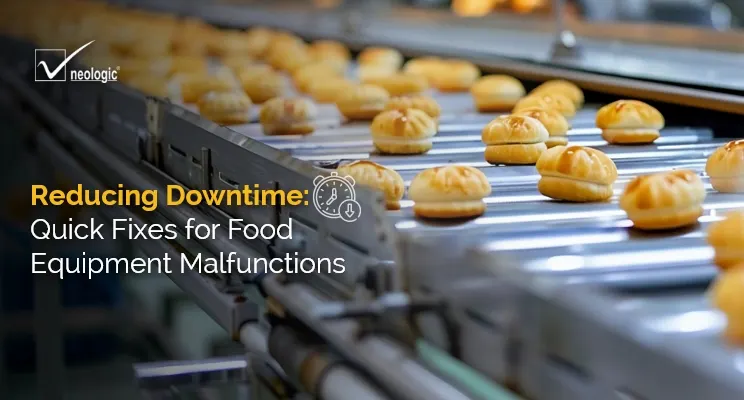
Reducing Downtime: Quick Fixes for Food Equipment Malfunctions
In industries where equipment reliability is crucial, downtime can be a costly setback. Whether in food processing, pharmaceuticals, or manufacturing, unplanned equipment failures can disrupt production, increase operational costs, and affect product quality. Reducing downtime requires a proactive approach, from preventive maintenance to quick fixes that minimize disruptions.
This blog explores key strategies and immediate solutions to mitigate equipment malfunctions and ensure seamless operations.
Understanding Downtime and Its Impact
What is Downtime?
Downtime refers to periods when equipment is non-operational due to malfunctions, maintenance, or external factors. It can be classified into:
- Planned Downtime: Scheduled maintenance or upgrades that ensure the long-term health of equipment.
- Unplanned Downtime: Unexpected failures that halt production and require immediate corrective action.
Cost of Downtime
Downtime has severe consequences on production and business operations, including:
- Production Loss: Equipment failures halt operations, leading to reduced output and failure to meet production targets.
- Increased Operational Costs: Emergency repairs, overtime pay, and wasted raw materials increase expenses.
- Quality Issues: Malfunctions during production can lead to defects, contamination, or product recalls.
- Customer Dissatisfaction: Supply chain disruptions due to downtime affect timely delivery, potentially leading to lost contracts and diminished business reputation.
Minimizing downtime is essential for maintaining efficiency, meeting customer expectations, and controlling costs.
Common Causes of Food Equipment Malfunctions
Understanding the root causes of food equipment malfunctions helps in implementing effective preventive measures. The most common causes include:
1. Lack of Regular Maintenance
Without routine inspections, essential components such as bearings, belts, and seals wear out, leading to unexpected breakdowns. Neglecting lubrication schedules results in increased friction, overheating, and component failure.
2. Electrical Failures
Power surges, voltage fluctuations, and faulty wiring can damage motors, control panels, and sensors. Poor grounding or worn-out electrical connections can also cause intermittent failures.
3. Mechanical Wear and Tear
Continuous operation leads to degradation of machine parts over time. If not replaced or repaired, worn-out components such as gears, chains, and hydraulic seals can cause complete machine failure.
4. Improper Equipment Usage
Operators exceeding load limits, using incorrect settings, or neglecting food equipment manufacturers’ guidelines can accelerate wear and tear, reducing equipment lifespan.
5. Environmental Factors
Exposure to dust, moisture, temperature variations, and chemical contaminants can corrode and degrade machine components, leading to operational inefficiencies.
6. Software and Control System Issues
Automated systems rely on software and programmable logic controllers (PLCs). Outdated or corrupted software, misconfigured parameters, or incompatible updates can cause malfunctions.
By identifying and addressing these issues, businesses can enhance equipment reliability and reduce downtime.
Quick Fixes for Food Processing Equipment Malfunctions
1. Immediate Troubleshooting Procedures
When a malfunction occurs following structured troubleshooting steps can quickly resolve minor issues before they escalate. The points below explain the steps that need to be followed:
- Check Power Supply: Ensure that power sources, breakers, and fuses are operational.
- Restart the System: Power cycling can reset minor software glitches and restore normal functionality.
- Inspect for Loose Connections: Verify that all electrical, pneumatic, and hydraulic connections are secure.
- Listen for Unusual Noises: Strange sounds such as grinding, knocking, or hissing often indicate mechanical or fluid system issues.
- Monitor Error Codes and Indicators: Many machines have built-in diagnostic systems that display error codes to pinpoint faults.
2. Lubrication and Cooling Checks
Lack of lubrication is a major cause of mechanical failure. Regularly applying appropriate lubricants to moving parts such as gears, bearings, and pistons reduces friction and prevents overheating. Similarly, ensuring cooling systems, fans, and heat exchangers are clean and functional prevents excessive heat buildup.
3. Software Updates and System Resets
Automated machines rely on software for operation. Ensuring firmware is updated and resetting control systems can resolve many technical glitches. Regularly backing up machine software settings helps restore operations quickly after unexpected failures.
4. Cleaning and Contaminant Prevention
Dust, debris, and moisture accumulation can impair sensors, motors, and moving parts. Implementing regular cleaning schedules and using protective covers in harsh environments extends equipment life.
5. Ensuring Proper Operator Training
Many failures occur due to incorrect handling. Regular training programs on machine operation, safety protocols, and troubleshooting empower operators to detect early warning signs and take preventive action.
Proactive Measures to Reduce Future Downtime
1. Implement Predictive Maintenance
Using sensors and data analytics, predictive maintenance tracks equipment conditions in real-time. This approach enables early detection of potential failures, allowing timely interventions before breakdowns occur.
2. Establish a Preventive Maintenance Schedule
Routine inspections, part replacements, and lubrication schedules help prevent unexpected failures. Maintenance plans should be based on food processing equipment manufacturer recommendations and operational history.
3. Use Condition Monitoring Techniques
- Vibration Analysis: Detects mechanical imbalances, bearing failures, and misalignment.
- Thermal Imaging: Identifies overheating components and electrical faults.
- Ultrasound Testing: Detects leaks in compressed air, hydraulic, and steam systems.
4. Create a Downtime Response Plan
Having a structured response plan ensures quick recovery from failures. This includes training staff on emergency troubleshooting, maintaining detailed failure logs, and having pre-established repair protocols.
5. Invest in Spare Parts Inventory
Stocking essential spare parts prevents delays caused by waiting for replacements. Identifying critical components prone to wear and stocking them in advance helps in quick repairs.
With Neologic Engineers annual maintenance contract, the worry of downtime or replacing parts reduces significantly. Our AMC offers unparalleled benefits to assure you a seamless processing experience.
In Conclusion, reducing equipment downtime is essential for maintaining production efficiency, controlling costs, and ensuring consistent product quality. Quick fixes such as checking power supply, lubricating moving parts, updating software, and replacing worn components can resolve many common failures. However, integrating long-term strategies like predictive maintenance, preventive maintenance schedules, operator training, and spare parts management ensures sustainable equipment reliability.
By implementing these strategies, industries can minimize disruptions, enhance productivity, and achieve long-term operational excellence.